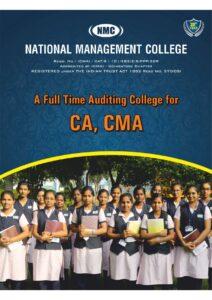NATIONAL MANAGEMENT COLLEGE, THUDUPATHI.
REVISION TEST – 11 (12.04.22)
PAPER : 3- BUSINESS MATHEMATICS,LOGICAL REASONING AND STATISTICS
TIME :1/2 HOUR
CLASS : CA – FOUNDATION MARKS :25 X 1 =25
CHOOSE THE BEST ANSWER
- Statistics has originated from Latin word,
- a) statista b) statistic c) status d) none of these
- statistics is defined in terms of numerical data in the
- a) singular sense b) plural sense c) a or b d) none of these
- The smallest entity or information about characteristics under study is called
- a) Information b) sample c) data d) content
- statistics is concerned with
- a) Qualitative information b) Quantitative information
- c) a & b d) a or b
- statistics is used in the field of
- a) Economics b) Business management
- c) commerce & industry d) All of these
- A variable is called continuous variable if
- a) A variable can assume any value from a given interval
- b) while obtaining the value of variable if someone has to measure
- c) a or b
- d) a & b
- A data on annual income of a person is collected , then annual income of a person is
- a) Numeric variable b) continuous variable
- c) Qualitative variable d) All of these
- which is the most accurate mode of data presentation is
- a) Diagrammatic method b) Tabulation
- c) Textual presentation d) none of these
- The quickest method to collect primary data is:
- a) personal interview b) indirect interview
- c) mailed questionnaire method d) telephone interview
- In tabulation , source of data, if any, is shown in the :
- a) stub b) body c) caption d) footnote
- Relative frequency for a particular class lies between:
- a) 0 and 1 b) 0 and 1 both inclusive c) -1 and 0 d) -1 and 1
- Horizontal bar diagram is used for
- a) qualitative data b) data varying over time
- c) data varying over space d) a or c
- the LCB is
- a) An upper limit to LCL b) a lower limit to LCL
- c) a and b d) a or b
- most of the commonly used frequency curves are
- a) mixed b) inverted J shaped c) U – Shaped d) Bell shaped
- The lower extreme point of a class is called
(a) lower class limit (b) lower class boundary
(c) both (d) none
- In a study relating to the labourers of a jute mill in West Bengal, the following information was collected.
‘Twenty per cent of the total employees were females and forty per cent of them were married. Thirty female workers were not members of Trade Union. Compared to this, out of 600 male workers 500 were members of Trade Union and fifty per cent of the male workers were married. The unmarried non-member male employees were 60 which formed ten per cent of the total male employees. The unmarried non-members of the employees were 80’. On the basis of this information, the ratio of married male non-members to the married female non-members is
(a) 1 : 3 (b) 3 : 1 (c) 4 : 1 (d) 5 : 1
- A table has
(a) four (b) two (c) five (d) none parts.
- Ogive is a
- a) Line diagram b) Bar diagram c) both d) none
- A sample study of the people of an area revealed that total number of women were 40% and the percentage of coffee drinkers were 45 as a whole and the percentage of male coffee drinkers was 20. What was the percentage of female non-coffee drinkers?
(a) 10 (b) 15 (c) 18 (d) 20
- Unequal widths of classes in the frequency distribution do not cause any difficulty in the construction of
(a) Ogive (b) Frequency polygon
(c) Histogram d) none.
- The best method to collect data, in case of a natural calamity, is
(a) Personal interview (b) Indirect interview
(c) Questionnaire method (d) Direct observation method.
- In case of a rail accident, the appropriate method of data collection is by
(a) Personal interview (b) Direct interview
(c) Indirect interview (d) All these.
- Which method of data collection covers the widest area?
(a) Telephone interview method (b) Mailed questionnaire method
(c) Direct interview method (d) All these.
- The amount of non-responses is maximum in
(a) Mailed questionnaire method (b) Interview method
(c) Observation method (d) All these.
- Some important sources of secondary data are
(a) International and Government sources
(b) International and primary sources
(c) Private and primary sources
(d) Government sources

